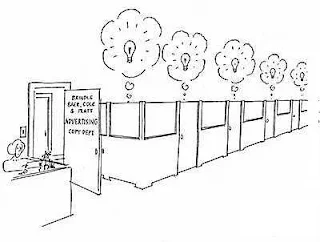Brainstorming purpose is to let creativity grow in the workplace and office managers should encourage such activity as often as possible amongst the working level.. However, we must not to let criticism kill the creativity spirit. The creative process must be supported, nurtured and embraced by the seniors in the office to enable possible good working results to be surfaced. There are some guidelines to making sure the process of brainstorming within the group and that the team agrees to them before any idea generation begins.
As ideas begin to flow, we must do everything in our ability to let these ideas flow. No one should start to pre-judge the ideas thrown on the table. The idea-generation is about coming out with as many ideas, not ranking them and then later put in time to evaluate them. Even if the person next to you throws out the stupidest idea which you think could be, let the process continue. Any comment or criticism will change the mood in the group, and they will start to clam up. The objective is to bring ideas to the surface, not to discuss them.
Once an idea hits the whiteboard, we will start to wonder how the idea would come to life, what would it cost? Who to take lead to start the ball rolling? What would the end result of the idea going to look like? What would the financial implications be? Where would the work idea take place? As important as that kind of thinking may be, it will crush the creativity idea very quickly and we need to thread our footpath very carefully.
Thus, fear is the biggest killer of creativity. We learn in schooldays that there is always one right answer and we should avoid making errors at all cost and with chinese culture, it inbuild in us that mistake made will make us “lose our face”. We need to release that fear to unlock our true creative potential. If we're leading the group, emphasize this before we begin. Tell our staff that every idea matters and that the whole point is to get a lot of ideas on the table. To best create an environment where everyone feels comfortable taking risks and has no fear of embarrassment or negative consequences, we need to set an example. If we as leader aren't afraid to toss out silly, outrageous ideas, we will likely to encourage others to release their fears as well, so that their most creative thinking can emerge. We can always learn a lot from the past, but it can also limit our ability to invent the future. Holding back an idea because we tried it once before and it didn't work out so well is limiting factor.. Imagine the world we live in changes none stop every day. An idea today comes into a world with an entirely new set of situations, market environment, technologies and customer preferences. If it happened not to work in the past, it may just have been ahead of its time. Or perhaps that idea, when revisited, will lead to a revised version that can carry the day. Every idea could be a new one at this moment, so share every single one that we believe has got it’s credit and substance.
Brainstorming sessions can easily dissolve into wandering and woolgathering. We need to watch out and not let it happen. An idea might remind someone of a past incident or it might lead to taking on a different creative challenge, or discussing a completely different topic. A right-brain creative state is so rare and so refreshing that its energy and excitement can cause a team to stray. To solve this, keep some of those not so relevant ones on a “parking lot” list to be discussed another time. This will keep the group focused on the task at hand while still making sure that important concepts are remembered and can get attention later.
Just as we manage the storming situation, the collective energy of the room can build into a frenzy, unleashing brilliant ideas while everyone has a great time, or it can devolve into yet another boring clock-watching drone session. We need to keep the energy up and maybe with some intermittent High-fives, cheers and positive vibes in between session. Let’s not allow negativity and energy-draining commentary bore the life from the room. Comparing ideas is an insidious form of criticism that needs to be checked at the door with all other left-brain habits. Comparing usually contains an implicit criticism. Brainstorming can become quite jolly, and the temptation to start joking about what comes up can be hard to resist and laughter at the expense of an idea is a fast way to kill it.
Brainstorming is a profoundly useful creative technique to generate solutions, new thoughts, improve work methodology, save cost, increase productivity, but only if we all know how to use it properly and be disciplined in the process of carrying it out in groups.








